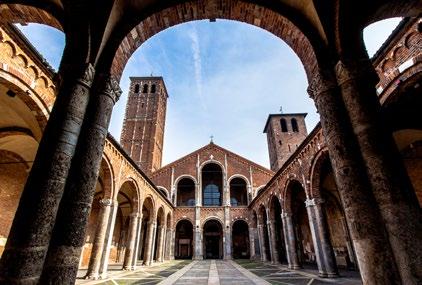
7 minute read
TOP IN TOWN
15 12
[ SIGHTSEEING ] Top in Town
Advertisement
3
6
© MARCOCIANNAREL/SHUTTERSTOCK.COM

6
MARCO BRESCIA © TEATRO ALLA SCALA

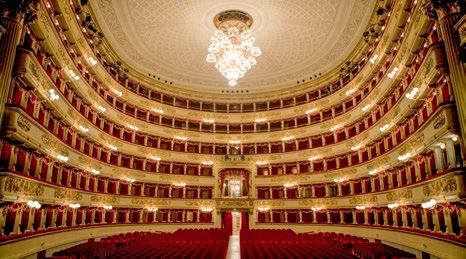
DUOMO 1
Among one of the most important Gothic buildings in the world, the church constructed over a period of 450 years is the symbol of Milan. To experience the Duomo at its most majestic you must ascend to the roof. Map F4
GALLERIA VITTORIO EMANUELE II 2
Sometimes known as “the living-room of the Milanese”, this elegant, four-storey arcade, housing luxury cafés and famous designer shops, is covered by a glass barrel vault and a beautiful glass cupola. Map F4
CASTELLO SFORZESCO 3
The ancient seat of the ruling Visconti, it was later rebuilt by Francesco Sforza and is now simply known by the Milanese as “Il Castello”. It houses a number of interesting museums and libraries. Its park is a favourite with old and young alike. Map E4
CENACOLO VINCIANO 4
One of the most famous attractions in the world, “The Last Supper” by Leonardo da Vinci is a 15th century large mural painting representing the scene of the last supper of Jesus narrated in the Gospel. This fragile masterpiece was painted by Leonardo using a technique that was chemically imperfect and by the early 16th century it has started to flake and decay, resulting in numerous restorations. Map D4
PALAZZO REALE 5
Formerly the residence of all those who governed Milan, from Napoleon to the Royal House of Savoy, the Royal Palace is currently one of the most important cultural centres in the city, hosting exhibitions of international renown. Near the Duomo, it’s the perfect place to escape the crowds of the Duomo’s square. Map F5
PIAZZA SCALA 6
The perfect location for the Gallerie d’Italia Museum and the opera house Teatro alla Scala. In the center of the square is the monument dedicated to Leonardo da Vinci. Map F4
MONTENAPOLEONE DISTRICT 7
Milan is known as one of the shopping capitals of the world and via Montenapoleone, together with the Golden Quad, is entirely given over to luxury shopping. Here the most important fashion designers offer their creations. Map F4-G4
7

1
© ALIAKSANDR ANTANOVICH/SHUTTERSTOCK.COM

SEE MAP PAGE 62
© ALEMASCHE72/SHUTTERSTOCK.COM
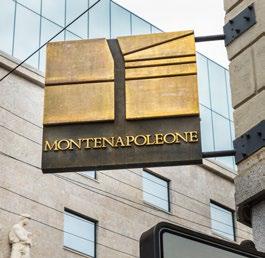
BRERA DISTRICT 8
This is an artsy neighbourhood which really comes to life at night. The Pinacoteca di Brera is one of the most important museums in Milan. Its permanent collections offer a wealth of exceptionally good Italian and foreign masterpieces. Map F3
AMBROSIANA 9
The Picture Gallery contains several exquisite works of art from the 15th through 17th centuries. The Biblioteca Federiciana has on show Leonardo’s Codex Atlanticus. the Pinacoteca is exhibiting the preparatory Cartoon for The ‘School of Athens’, one of the best-known paintings by Raphael. Map F5 ago to ferry people and merchandise to Milan. This network was perfected in 1457 by Leonardo da Vinci. Today, the area is bursting with trendy dining and nightlife spots. Map E6
SAN SIRO STADIUM 11
With a capacity of 80,000 seats, it is the largest stadium in Italy and the 4th in Europe. Off Map
SANT’AMBROGIO 12
One of the most ancient churches in Milan, it was built in 379-386 A.D., in an area where martyrs had been buried. Map E5
PORTA NUOVA DISTRICT 13
A vibrant, futuristic district overlooking two neighbourhoods: the Garibaldi and Isola districts. The heart of the area is the large raised square dedicated to architect and designer Gae Aulenti. Just a little further on you will encounter the Bosco Verticale with the new Biblioteca degli Alberi. Map S2
TRIENNALE MILANO 14
Since 1923 this is an international institution which organises exhibitions and events about arts, designs, architecture, fashion, cinema, photography and theatre. Map D3
CIMITERO MONUMENTALE 15
A real outdoor museum catering, on the one hand to the whims of the elite of Milan’s society, and on the other to works of art by famous sculptors of various eras. Map E1
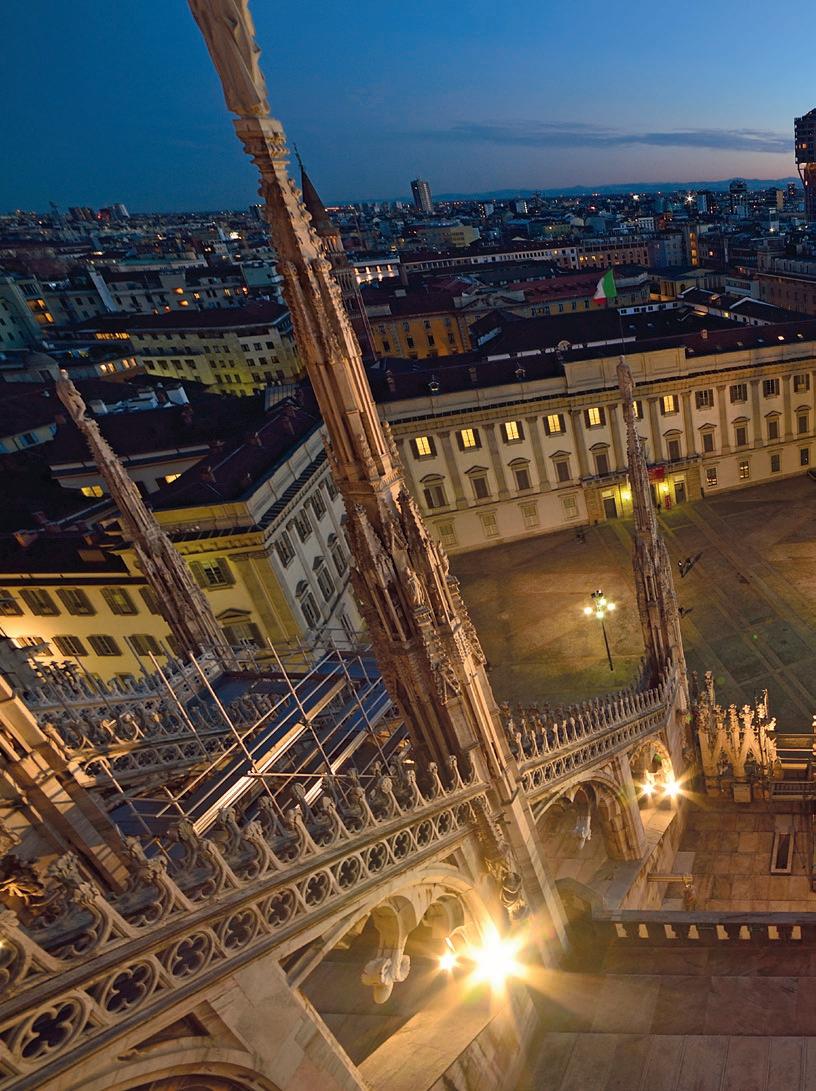
THE DUOMO'S TERRACES OVERLOOKING THE CITY
After crossing the threshold of its 18th century − façade in Candoglia marble, the interior of the Cathedral is revealed in all its majesty. One of the most important Gothic buildings in the world, the church, constructed over a period of 450 years (begun 1386), is the symbol of Milan. Built in the shape of a Latin cross, the cathedral is divided by soaring pillars into five naves, the largest of which measures 45 metres in height. Its inside columns measure 3 and a half metres in diameter. − The interior boasts an apse with a large rose window, stained glass windows decorated with episodes from the Bible, chapels and high marble columns with capitals featuring statues of saints. − To experience the Duomo at its most majestic you must ascend to the roof (either by elevator or by steps) where you will be surrounded by an outburst of pinnacles, turrets and marble statuary and, naturally, the city’s famed golden “Madonnina”. Here you can wander among 135 spires and 3,400 statues. − Guided tours for small groups help visitors learn about the secrets behind the Duomo’s construction. The tour starts from the back of the choir which leads to the Crypt housing the tomb of San Carlo Borromeo, and then moves on to the Archaeological Area where you’ll find the remains of the Battistero di San Giovanni alle Fonti, dating back to 397 A.D. This is where Sant’Ambrogio christened St. Augustine. Next is the old Basilica of Santa Tecla (4th century). − Before accessing the Cathedral and its treasures, visit the nearby Museo del Duomo, located inside Palazzo Reale. The museum houses more than 150 masterpieces from the 15th century to the present time, including statues, architectural models, plaster casts, terracottas and paintings. − If you’re on a tight schedule but want to learn more about the secrets of the Duomo, you can take advantage of the new Duomo Milano App for smartphones, featuring images and content in 9 languages including Italian, English, French, German, Spanish, Russian, Chinese, Japanese and Portuguese.

www.duomomilano.it
PH © VENERANDA FABBRICA DEL DUOMO
BIBLIOTECA BRAIDENSE
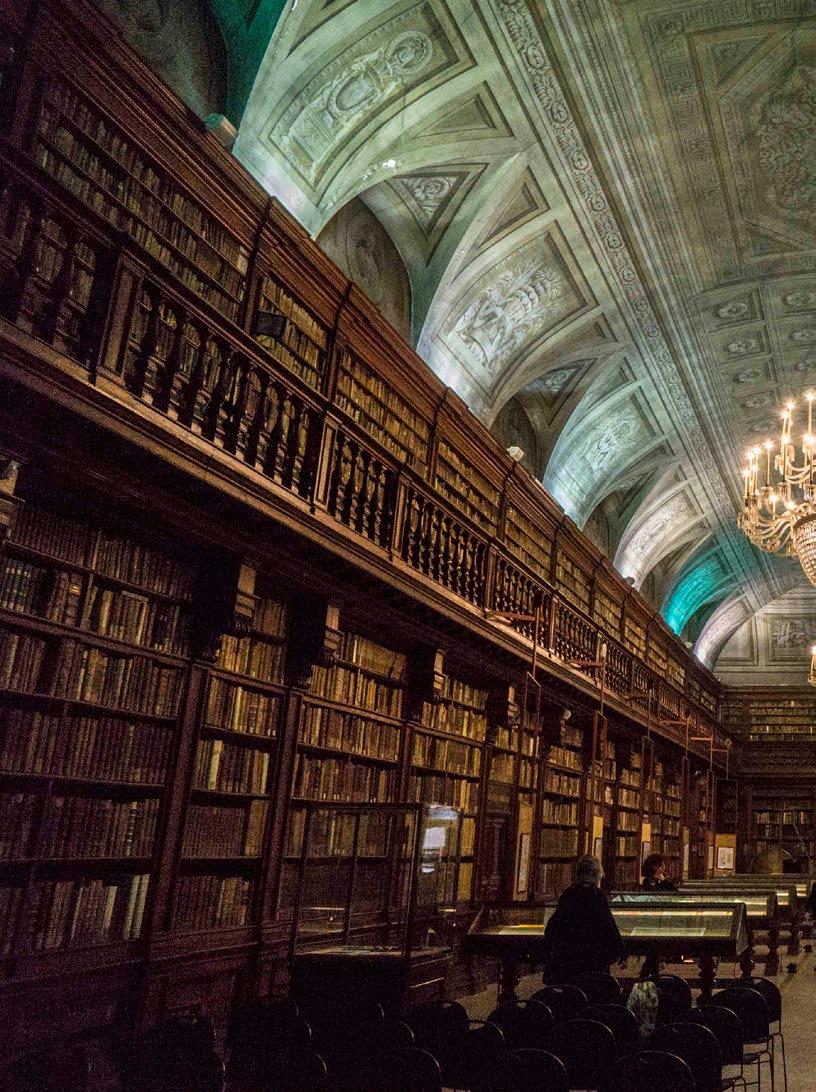
AN “IDEAL LIBRARY” IN THE CITY
The Biblioteca Braidense − is a place dedicated to initiatives, projects and exhibitions aimed at promoting reading and the book as an object of art, and has consolidated its reputation as an “ideal library” in the city. The library was commissioned by Maria Theresa of Austria in 1786, and has represented a place of cultural exchange for the city of Milan since it first opened. − It is the third largest library in Italy, due to its volume of publications, and has a collection of, 1,500,000 books, including 2,000 manuscripts, 350 of which date back to medieval times, 2,306 incunabula and 25,000 sixteenth century editions. − The collection also includes catalogues, religious books housed in the reading room, a rare collection of
letters and first editions by
Alessandro Manzoni, plus objects and manuscripts that belonged to Italian novelist Lalla Romano. − Its magnificent Neoclassical rooms, which contain historic books of immeasurable value, feature
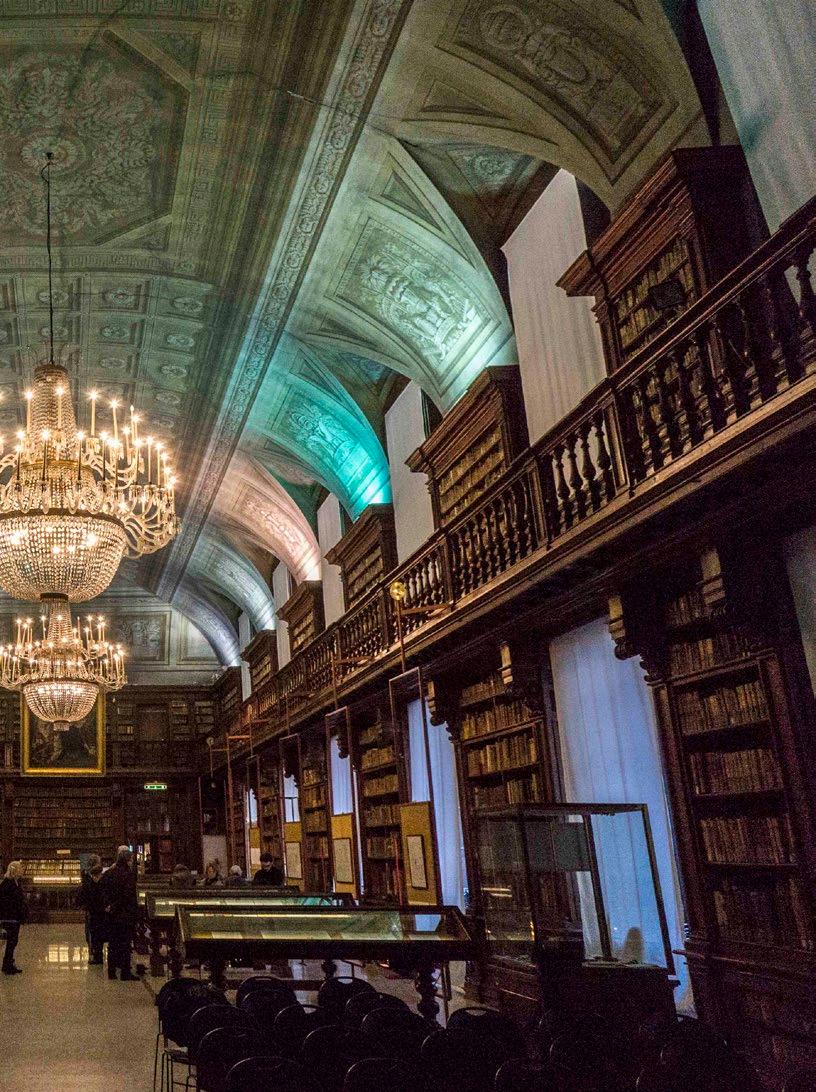
the library’s original wooden shelves and furnishings, crystal chandeliers, frescoed ceilings, and a collection of antique paintings that transcend the traditional concept of a library, creating an environment that encourages the promotion of the book as an object of art. − The Biblioteca Braidense is an international reference point for initiatives, projects and exhibitions, all aimed at safeguarding and promoting reading and the book per se, with a particular emphasis on the concept of preservation and cataloguing. − Until November 14, 2020, the Biblioteca Braidense (Sala Maria Teresa) dedicates to Giovan Battista Piranesi, the greatest engraver in the history of Italian art, an exhibition that showcases an
extraordinary collection of
97 works including catalogs, drawings, engravings, books, paintings, as well as 66
documentary photographs
and two videos that testify to the link between Piranesi and the city of Milan, where the artist has never been.





